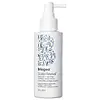What's inside
What's inside
 Key Ingredients
Key Ingredients

 Benefits
Benefits

 Concerns
Concerns

 Ingredients Side-by-side
Ingredients Side-by-side

Water
Skin ConditioningSodium Laureth Sulfate
CleansingCocamidopropyl Betaine
CleansingGlycerin
HumectantCocamide Mea
EmulsifyingAcrylates Copolymer
Sodium Citrate
BufferingCocamide Mipa
EmulsifyingHexylene Glycol
EmulsifyingSodium Hydroxide
BufferingArgania Spinosa Shell Powder
AbrasiveSodium Chloride
MaskingCitric Acid
BufferingSodium Benzoate
MaskingPolyquaternium-10
PEG-55 Propylene Glycol Oleate
Propylene Glycol
HumectantSalicylic Acid
MaskingCharcoal Powder
AbrasiveBenzyl Salicylate
PerfumingHexyl Cinnamal
PerfumingBenzyl Alcohol
PerfumingLimonene
PerfumingButylene Glycol
HumectantCI 77000
Cosmetic ColorantCitronellol
PerfumingGeraniol
PerfumingPolyglycerin-10
HumectantPolyglyceryl-10 Myristate
Skin ConditioningPolyglyceryl-10 Stearate
Skin ConditioningTocopherol
AntioxidantBisabolol
Masking2-Oleamido-1,3-Octadecanediol
Skin ConditioningSafflower Glucoside
Hydroxycitronellal
PerfumingCI 77499
Cosmetic ColorantSilica
AbrasiveSodium Dehydroacetate
PreservativeSodium Hyaluronate
HumectantHydrolyzed Pearl
Skin ConditioningAlteromonas Ferment Extract
Skin ConditioningPotassium Sorbate
PreservativeSorbic Acid
PreservativeBHT
AntioxidantParfum
MaskingCeramide AP
Skin ConditioningWater, Sodium Laureth Sulfate, Cocamidopropyl Betaine, Glycerin, Cocamide Mea, Acrylates Copolymer, Sodium Citrate, Cocamide Mipa, Hexylene Glycol, Sodium Hydroxide, Argania Spinosa Shell Powder, Sodium Chloride, Citric Acid, Sodium Benzoate, Polyquaternium-10, PEG-55 Propylene Glycol Oleate, Propylene Glycol, Salicylic Acid, Charcoal Powder, Benzyl Salicylate, Hexyl Cinnamal, Benzyl Alcohol, Limonene, Butylene Glycol, CI 77000, Citronellol, Geraniol, Polyglycerin-10, Polyglyceryl-10 Myristate, Polyglyceryl-10 Stearate, Tocopherol, Bisabolol, 2-Oleamido-1,3-Octadecanediol, Safflower Glucoside, Hydroxycitronellal, CI 77499, Silica, Sodium Dehydroacetate, Sodium Hyaluronate, Hydrolyzed Pearl, Alteromonas Ferment Extract, Potassium Sorbate, Sorbic Acid, BHT, Parfum, Ceramide AP
Water
Skin ConditioningPropanediol
SolventArginine
MaskingBetaine
HumectantSalicylic Acid
MaskingLactic Acid
BufferingGluconolactone
Skin ConditioningMelaleuca Alternifolia Leaf Oil
AntioxidantMentha Piperita Oil
MaskingSodium PCA
HumectantPanthenol
Skin ConditioningHyaluronic Acid
HumectantCharcoal Powder
AbrasivePolyglyceryl-4 Caprate
EmulsifyingMethyl Diisopropyl Propionamide
MaskingZingiber Officinale Root Oil
MaskingBenzyl Alcohol
PerfumingIngredients Explained
These ingredients are found in both products.
Ingredients higher up in an ingredient list are typically present in a larger amount.
Benzyl Alcohol is most commonly used as a preservative. It also has a subtle, sweet smell. Small amounts of Benzyl Alcohol is not irritating and safe to use in skincare products. Most Benzyl Alcohol is derived from fruits such as apricots.
Benzyl Alcohol has both antibacterial and antioxidant properties. These properties help lengthen the shelf life of products. Benzyl Alcohol is a solvent and helps dissolve other ingredients. It can also improve the texture and spreadability.
Alcohol comes in many different forms. Different types of alcohol will have different effects on skin. This ingredient is an astringent alcohol.
Using high concentrations of these alcohols are drying on the skin. They may strip away your skin's natural oils and even damage your skin barrier. Astringent alcohols may also irritate skin.
Other types of astringent alcohols include:
According to the National Rosacea Society based in the US, you should be mindful of products with these alcohols in the top half of ingredients.
Any type of sanitizing product will have high amounts of alcohol to help kill bacteria and viruses.
Learn more about Benzyl AlcoholCharcoal powder comes from grounded charcoal. Charcoal can originate from peat, bamboo, coal, wood, coconut shell, or petroleum.
This ingredient has absorbent properties, making it great at absorbing oil.
Salicylic Acid (also known as beta hydroxy acid or BHA) is a well-known ingredient for treating skin that struggles with acne and clogged pores. It exfoliates both the skin's surface and deep within the pores to help clear out buildup, control oil, and reduce inflammation.
Unlike AHAs (alpha hydroxy acids), salicylic acid is oil-soluble. This allows it to penetrate into pores which makes it especially effective for treating blackheads and preventing future breakouts.
Salicylic acid is also known for its soothing properties. It has a similar structure to aspirin and can calm inflamed or irritated skin, making it a good option for acne-prone skin that is also sensitive.
Concentrations of 0.5-2% are recognized by the U.S. FDA as an over-the-counter topical acne product.
It can cause irritation and/or dryness if one's skin already has a compromised moisture barrier, so it's best to focus on repairing that before introducing this ingredient into your routine.
While salicylic acid does not increase sun sensitivity, it’s still important to wear sunscreen daily to protect your skin.
If you are looking for the ingredient called BHA or Butylated Hydroxyanisole, click here.
Learn more about Salicylic AcidWater. It's the most common cosmetic ingredient of all. You'll usually see it at the top of ingredient lists, meaning that it makes up the largest part of the product.
So why is it so popular? Water most often acts as a solvent - this means that it helps dissolve other ingredients into the formulation.
You'll also recognize water as that liquid we all need to stay alive. If you see this, drink a glass of water. Stay hydrated!
Learn more about Water